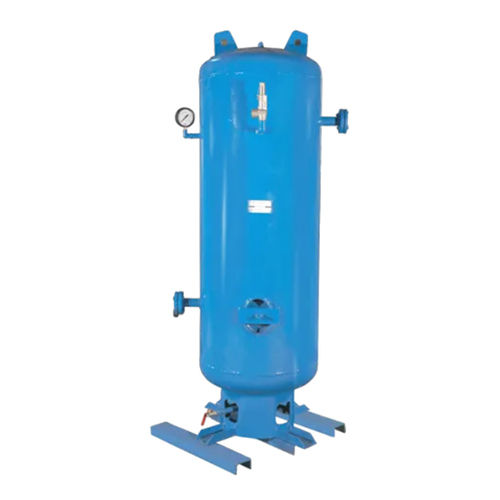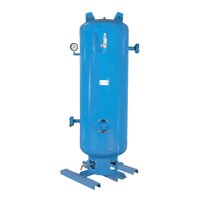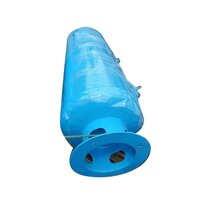Call us: 08045476447
Air Receiver Storage Tank
33000 INR/Unit
Product Details:
- Color Blue
- Usage Industrial
- Product Type Air Receiver Storage Tank
- Condition New
- Material Mild steel
- Lubrication Type Lubricated
- Click to View more
X
Air Receiver Storage Tank Price And Quantity
- 10 Unit
- 33000 INR/Unit
Air Receiver Storage Tank Product Specifications
- Mild steel
- Lubricated
- Blue
- New
- Air Receiver Storage Tank
- Industrial
Air Receiver Storage Tank Trade Information
- Cash Advance (CA)
- 1000 Unit Per Month
- 10 Days
- All India
Product Description
<p style="text-align: justify;">An essential part of compressed air systems is an air receiver storage tank, commonly referred to as an air receiver tank. It acts as a buffer between the distribution system and the compressor by acting as a reservoir for compressed air storage. The tank serves as a storage buffer during periods of high demand and enables for optimum air pressure stabilisation, decreasing pulsation in the system. Additionally, it aids in removing moisture and grease from compressed air, improving air quality. The air receiver storage tank is essential for maintaining a reliable and effective compressed air supply, which promotes the efficient functioning and durability of pneumatic equipment in industrial settings.</p><p style="text-align: justify;"> </p><h2 style="text-align: justify;">Benefits and Features of an Air Receiver Storage Tank: </h2><h3 style="text-align: justify;">Features: </h3><p style="text-align: justify;">1. Storage of Compressed Air: An air receiver tank's main characteristic is its capacity to store compressed air, which serves as a reserve during times of high demand.</p><p style="text-align: justify;">2. Pressure Stabilisation: By assisting in the maintenance of a constant and stable air pressure in the compressed air system, the tank helps to lessen pressure pulsations and variations.</p><p style="text-align: justify;">3. Air receivers allow moisture to condense and settle, which keeps water from getting into equipment further down the line and improves the quality of the air.</p><p style="text-align: justify;">4. Air cooling is encouraged by the storage tank, which lowers the load on the compressor and increases energy efficiency.</p><p style="text-align: justify;">5. Safety Relief Valve: To avoid overpressurization and guarantee safe operation, air receivers are fitted with safety relief valves.</p><p style="text-align: justify;"><br /></p><h3 style="text-align: justify;">Benefits: </h3><p style="text-align: justify;">1. Enhanced Efficiency: The air receiver reduces compressor cycling, which increases system efficiency and lowers energy usage.</p><p style="text-align: justify;">2. Equipment Life Extension: The air receiver prolongs the compressor's life and lowers maintenance expenses by minimising wear and tear.</p><p style="text-align: justify;">3. Optimal Air Supply: This guarantees that compressed air is available continuously and reliably, supporting the efficient operation of pneumatic tools and equipment.</p><p style="text-align: justify;">4. Cost Savings: The air receiver makes it possible for the compressor to run more effectively, which reduces the amount of energy used.</p><p style="text-align: justify;">5. Reduced Noise: The tank's buffer effect lowers noise levels, which makes the workplace more peaceful.</p><p style="text-align: justify;">6. Air receivers aid in the compliance with rules and safety requirements for compressed air systems.</p><p style="text-align: justify;"> </p><p style="text-align: justify;">An air receiver storage tank has many features and advantages that make it a crucial part of compressed air systems. These advantages include increased productivity, equipment protection, and greater safety in a variety of industrial applications. </p>
FAQs of Air Receiver Storage Tank:
Q: What is the material of the Air Receiver Storage Tank?
A: The material of the Air Receiver Storage Tank is mild steel.Q: What is the lubrication type of the Air Receiver Storage Tank?
A: The lubrication type of the Air Receiver Storage Tank is lubricated.Q: What is the usage of the Air Receiver Storage Tank?
A: The Air Receiver Storage Tank is used for industrial purposes.Q: What is the color of the Air Receiver Storage Tank?
A: The color of the Air Receiver Storage Tank is blue.Q: Is the Air Receiver Storage Tank new or used?
A: The Air Receiver Storage Tank is new.Enter Buying Requirement Details

 English
English Spanish
Spanish French
French German
German Italian
Italian Chinese (Simplified)
Chinese (Simplified) Japanese
Japanese Korean
Korean Arabic
Arabic Portuguese
Portuguese





